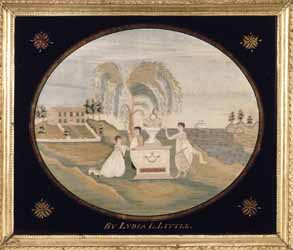Collections Online
James Little mourning needlework
To order an image, navigate to the full
display and click "request this image"
on the blue toolbar.
-
Choose an alternate description of this item written for these projects:
- Staff Favorites
- Main description
[ This description is from the project: Object of the Month ]
From the mid-18th through the mid-19th century, the creation of an ornamental needlework sampler was an essential element of a well-to-do girl's education. While all women, rich and poor alike, were expected to know plain sewing in order to keep house, ornamental sampler making constituted an accomplishment appropriate specifically to the upper classes. Girls learned the skill in private schools and female academies along with other "lost" decorative arts (quilling, wax-work, shell-work), dancing, and foreign languages.
Samplers fall into a few general categories, with infinite variations on the basic themes: marking samplers, comprising only an alphabet or a short verse (see Hannah Storer's sampler); pictorial samplers featuring pastoral scenes, views of important local buildings, or biblical scenes; coats of arms; and mourning samplers, such as the one shown here, by Lydia Little of Scituate.
According to Betty Ring, a leading scholar in this field, mourning samplers came into vogue after 1800, inspired by memorials produced upon the death of George Washington. While some samplers recall historical figures, others memorialized members of the student's own family. Lydia Little, to whom this sampler is attributed, was born in Marshfield, Mass., on October 10, 1790, to Capt. James and Lydia (Young) Little. The sampler incorporates classic elements of mourning art—the willow tree, an obelisk inscribed "Capt. James Little Aet. 45," and grieving family members—as well as a ship (presumably Captain Little's) sailing in the background. The figures probably represent Lydia, her brother James, and sister Lucy.
Lydia created this piece after 1803—the year her father died-when she was in her early to mid teens. Worked in silk threads on a silk background, it also features watercolor highlights and painted details; typically, the student would do the embroidery, with painted details added later by her instructor. The excellent workmanship on this sampler demonstrates that Lydia, who married Elisha James in 1808, achieved a high level of accomplishment in her education, although it is not known which school she attended.

